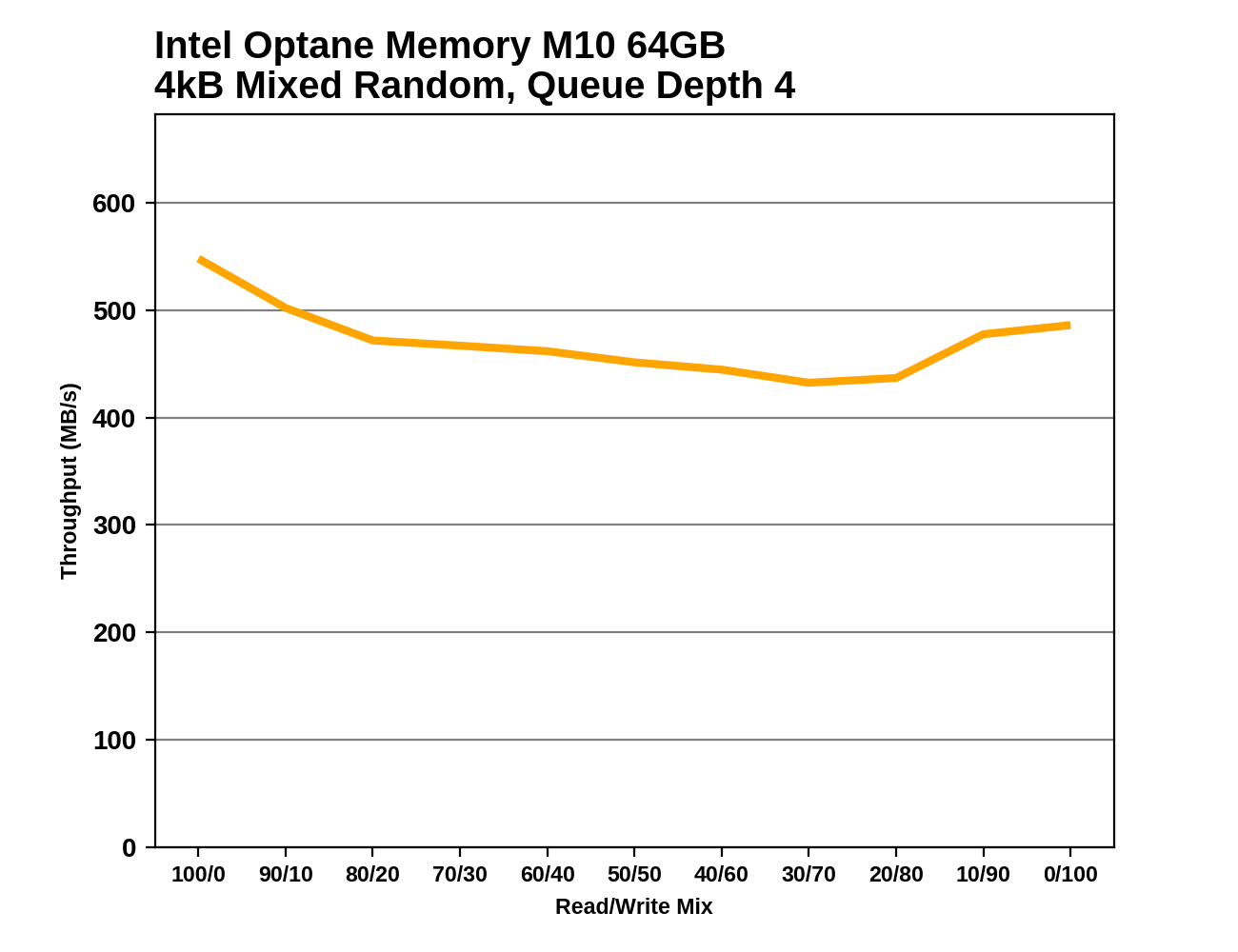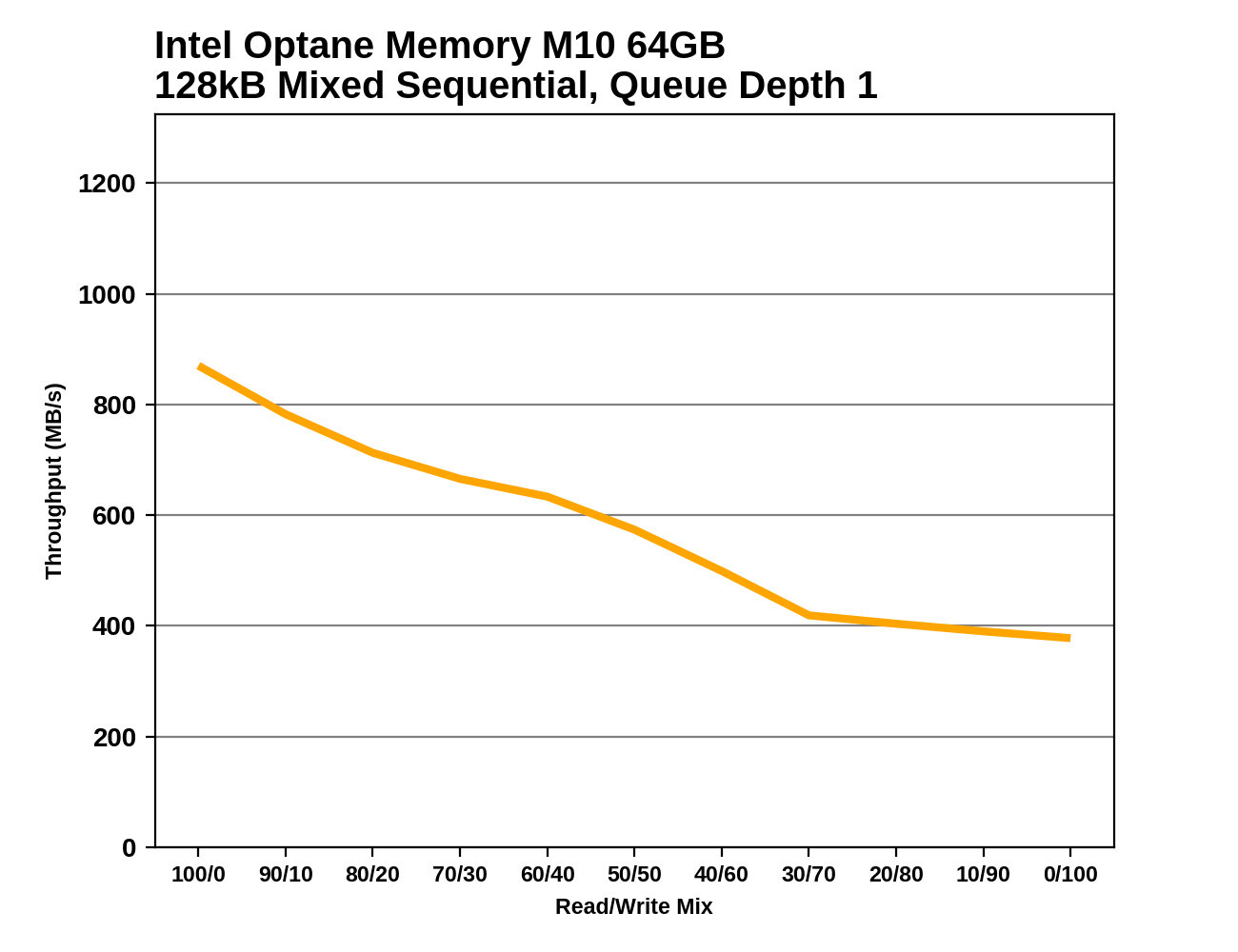The Intel Optane Memory M10 (64GB) Review: Optane Caching Refreshed
by Billy Tallis on May 15, 2018 10:45 AM EST- Posted in
- SSDs
- Storage
- Intel
- PCIe SSD
- SSD Caching
- M.2
- NVMe
- Optane
- Optane Memory
Mixed Random Performance
Our test of mixed random reads and writes covers mixes varying from pure reads to pure writes at 10% increments. Each mix is tested for up to 1 minute or 32GB of data transferred. The test is conducted with a queue depth of 4, and is limited to a 64GB span of the drive. In between each mix, the drive is given idle time of up to one minute so that the overall duty cycle is 50%.

Unsurprisingly, the mixed random I/O test produces crap performance from the hard drive and the two cache configurations where the cache is too small for this test. The 118GB Optane SSD 800P is more cache than this test needs, and it performs almost as well as the Optane SSD 900P.
 |
|||||||||
When used as a cache for this test, the largest Optane SSD 800P shows slightly different performance characteristics than when it is treated as a standalone drive, but in either case it is a strong performer across the board. The smaller Optane drives aren't large enough to cache the entire working set of this test and can't do much to improve performance over the hard drive.
Mixed Sequential Performance
Our test of mixed sequential reads and writes differs from the mixed random I/O test by performing 128kB sequential accesses rather than 4kB accesses at random locations, and the sequential test is conducted at queue depth 1. The range of mixes tested is the same, and the timing and limits on data transfers are also the same as above.

All of the Optane configurations easily outperform the SATA drives on the mixed sequential I/O test. The 64GB and 118GB modules are tied when tested as standalone drives and close when tested as cache devices, and the cache performance is 30-40% faster than the standalone SSD performance. The 32GB module is substantially slower and performance is much closer between caching and standalone SSD use.
 |
|||||||||
The performance improvements in the caching configurations over the standalone drive configurations generally apply throughout the mixed sequential test. The main exception is in the early phases of the test with the 32GB cache, where cache performance falls far short of the standalone drive performance. Once the proportion of reads has dropped to 70%, the cache configuration comes out ahead.










96 Comments
View All Comments
Flunk - Tuesday, May 15, 2018 - link
For $144 you can get a 256GB M.2 SSD, big enough to use as a boot drive. Even as a cache for a slow hard-drive (which means you also need to buy a hard drive, possibly bumping the cost up to 512GB SSD prices) means this product doesn't make any sense at all. Maybe it made sense when they started development, but it doesn't now.dullard - Tuesday, May 15, 2018 - link
Flunk, the reason to get these drives is that an Optane cache + standard hard drive is FASTER and LARGER CAPACITY than the 512 GB SSD. If you don't like larger or faster, then go ahead with just a SSD.bananaforscale - Tuesday, May 15, 2018 - link
You totally miss the point. An SSD is cheaper and irrelevantly slower and you can use it for caching.wumpus - Wednesday, May 16, 2018 - link
You can? You used to be able to use a 64GB cache on Intel boards, and you can use a 512GB cache on just released AMD (470) boards [unfortunately, that bit of the review still has [words] under the storeMI section].If you can pull it off, a 512GB caching SATA drive makes all kinds of sense for anything you might want to do with this. As near as I can tell, Optane's only advantage is that they provide the caching software without having to hit windows and motherboard requirements. Which makes the whole "optane is so fast" advantage a bit of a joke.
Wake me up when optane has the endurance to be used with a DDR4 interface (presumably with caching HBM2/Intel system DRAM). This doesn't give any advantage (besides providing the software license).
shadowx360 - Wednesday, May 23, 2018 - link
Windows Storage Spaces or ZFS can do it. Right now I have 2x256GB SSDs mirrored to accelerate a 5x4TB hard drive array. I set 100GB as a write-back cache that automatically flushes to the HDDs, so random write is SSD-level quick. I also pin about 20GB of files to the SSDs permanently and the rest is rotated between free space and system-managed hot files.Lolimaster - Tuesday, May 15, 2018 - link
400-500MB/s vs 1.5GB/s, not really much of a difference, either way you will have to wait for that HDD to write to the cache drive 1st at 100MB/s or less (since they're small files, HDD works faster on transfer with larger files).If you got a set of constantly used files, move those to the SSD, problem solved.
evernessince - Wednesday, May 16, 2018 - link
Or you buy an X470 motherboard or pay $10 to get StoreMI, which also makes a cache but is much cheaper and can use any SSD as a cache, which saves you money, allot of it.CheapSushi - Wednesday, May 16, 2018 - link
You can use any Optane drive like ANY SSD too.Spunjji - Wednesday, May 16, 2018 - link
It's faster in zero real-world situations. It's larger than an SSD bought for the same total money, but not larger than an SSD at the same cost as the optane drive (256GB) + the same HDD you'd use for optane caching. Your point is... flawed.Keljian - Tuesday, May 29, 2018 - link
This is actually not true. It's faster for Mysql/sqlite in 4k situations when the cache is tuned for it. What uses sqlite? - games, most office software, web browsers..